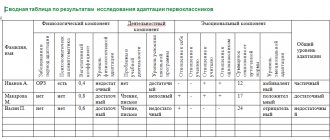Adaptation is a mechanism for the socialization of an individual, his inclusion in a system of new relationships and social connections. When a first-grader enters school, he finds himself in completely different living conditions and a new social circle. A psychological analysis of the characteristics of first-graders’ adaptation to school revealed the following problems.
- Unlike kindergarten, where preschoolers were considered the oldest children in the group, first-graders are the youngest students.
- In kindergarten, the child had a gentle daily routine, while at school there was a clear routine and strict discipline.
- A first-grader needs to move from play to educational cognitive activity.
- Children find themselves in a more strict system of requirements for them.
- Many new people appear around the first grader, both adults and children, with whom it is necessary to establish connections.
Adaptation for a first-grader can last from two weeks to six months. The length of the adaptation period depends on the following factors:
- individual characteristics of the child;
- level of readiness for school;
- degree of development of social skills.
The goal of the adaptation process is the adequate inclusion of a first-grader in a new social situation.
ADAPTATION FEATURES
Psychologists note some features and problems of adaptation of first-graders to school, which are associated with constant development and changes in the modern school:
- adaptation is greatly influenced by technological progress, informatization of society and the introduction of educational standards, which complicates getting used to school;
- The Federal State Educational Standard requires from the child not only subject knowledge and skills, but also personal and meta-subject results, which are reflected in the portrait of a primary school graduate;
- a sharp change in social role: yesterday’s preschooler becomes a student. This is a great responsibility for him: a new regime, the need to organize his activities, a new system of rights and responsibilities.
It is not without reason that the period of adaptation of a first-grader to school is considered a difficult life situation for both the student and the parents. The stress that a child experiences at the beginning of the school year is compared to the emotions of an adult who has simultaneously moved to another city, changed jobs, and is renovating a new home.
STRUCTURE AND TYPES OF ADAPTATION
There are the following stages of a child’s adaptation to school.
- Approximate (2-3 weeks). At this stage, the body reacts violently to significant changes in the child’s life, all its systems work to the limit, work takes place in a stressful mode. The student is just getting acquainted with the new environment and conditions, looking for opportunities to adapt.
- Unstable adaptation (2-3 weeks). At the next stage, he begins to get used to the new rules, requirements and norms of behavior. The body looks for optimal solutions and reacts to stress less anxiously.
- Relatively stable adaptation (from 1.5 months to a year). By this stage, all ways to respond to emerging situations have been found, and the child calmly acts on the basis of the acquired experience. The body is no longer stressed and does not force all systems to work at their limit.
In addition to the stages, psychologists and teachers distinguish three types of adaptation: social, physiological and psychological.
SOCIAL
It assumes that the child must master a new social role - the role of a student. Includes the following components:
- ability to listen to the teacher;
- understanding your responsibilities and fulfilling them;
- following school procedures and requirements;
- good relationships with classmates;
- absence of conflict situations;
- ability to independently organize and complete tasks.
PHYSIOLOGICAL
It suggests that the child’s body experiences great stress due to strong changes associated with school. Even a small load causes the child to experience severe stress. This often leads to overwork.
Indicators of physiological adaptation also include:
- well-being;
- sleep quality;
- performance;
- appetite;
- various diseases and their exacerbation.
PSYCHOLOGICAL
This type of adaptation depends on the child’s readiness for school: the more developed the mental processes are, the more successful it will be.
Evaluated according to the following parameters:
- motivation to study;
- willingness to perform tasks and understand them;
- level of development of cognitive processes;
- daily mood;
- the ability to evaluate yourself and your work.
Adaptation disorder (adaptive reactions) - symptoms and treatment
The development of adaptation disorder is based on a person’s reduced ability to analyze, evaluate and adapt to changing conditions and circumstances of life.
The development of adaptation disorder is initiated by a stress factor - a situation or change in conditions that is assessed and perceived by the individual as threatening.
Stress (according to T. Cox, professor of psychology at the University of Nottingham) arises as a response when there are significant differences between the demands placed on an individual and her ability to cope with these demands.
A psychotraumatic factor can both trigger an adaptation disorder and affect the patient’s condition throughout the entire illness. Thus, a stress factor can be both an initiating factor (lead to the development of the disorder) and a main link in the pathogenesis of adaptation disorder (present throughout the entire disease) [2]. Examples of stress factors: loss of a loved one, migration, job loss.
The inability to achieve results that satisfy significant needs leads to a tense state. The expected result, planned (modeled) states or events do not always correspond to reality. For example, when moving to another country, a person may expect to settle in easily and quickly find a job, but is faced with difficulties and the impossibility of realizing his plans. It is this contradiction that causes an emotional reaction. As a result, the autonomic nervous system and endocrine mechanisms that regulate behavioral reactions are activated - adrenaline is released into the blood from the adrenal medulla, corticoliberin is secreted in the hypothalamus, adrenocorticotropic hormone in the pituitary gland and glucocorticoids in the adrenal cortex.
Thus, the body’s adaptive reactions during chronic psycho-emotional stress and overstrain consist of the activation of a number of biological processes. This complex of vegetative and energetic shifts is equivalent to the first stage of stress - the mobilization of energy resources for an urgent solution to a vital task. A sudden change in living conditions causes an alarm reaction, which consists of alertness (behavior), the release of stress hormones into the bloodstream (endocrinology) and activation of the autonomic system (physiology). Subsequently, anxiety is replaced by a detailed stress response. Damage to health is caused by unfavorable changes in living conditions, which could not be avoided by the time the body’s protective resources were exhausted.
An important link in the development of adaptation disorders is the individual characteristics of a person’s neuropsychic response, his hypersensitivity and vulnerability. Personality traits that predispose to the disorder:
- sensitivity;
- vulnerability;
- suspiciousness;
- impulsiveness;
- increased anxiety;
- depressive mood (tendency to dramatize a situation);
- negative experience of adaptation to various life situations in the past;
- decreased self-esteem;
- immaturity of personality.
A psychotraumatic factor causes and maintains a maladaptive pathological response of the body in the form of affective and behavioral disorders. As a result, a pathogenetic dynamic chain process is launched [2][3]. For example, the loss of a job (the main source of livelihood) causes a depressed state, a feeling of loss of control over the situation, anxious thoughts, and a feeling of futility of actions. This can lead to self-isolation and disrupt interaction with society. Such changes cause affective, primarily depressive disorders, which do not help solve problems, but, on the contrary, worsen the situation [7].
The development of adjustment disorders is often facilitated by social factors, such as lack of support from the environment.
LEVELS OF ADAPTATION
When entering school, dramatic changes occur in a child’s life. They affect those aspects related to study. Experts identify the following levels of adaptation of first-graders to school.
HIGH LEVEL
The child quickly adapts to school life (within 2-6 weeks). A first-grader has a positive attitude towards school, is motivated to learn, is ready to learn new things, and acquires knowledge and skills quickly. Such a child copes well with the school curriculum and is able to solve tasks of increased complexity. The student can organize his activities and follow the teacher’s instructions. He has good relationships with classmates and has friends. He has no health problems and is rarely in a bad mood.
AVERAGE LEVEL
The student gets used to school for a long time (from 2 to 3 months), but at the same time is not particularly worried or upset about visiting it. Periodically feels tired and experiences mood swings. Masters program material well and performs standard tasks. Accurately acts according to the teacher’s instructions, sometimes needs his help and control. He is attentive and diligent in class. Friendships with classmates are developing well.
LOW LEVEL
It is very difficult for a child to get used to school; he experiences negative emotions towards it. Has no motivation to study, only partially assimilates the material, new knowledge does not arouse interest. Often violates discipline, does not listen to teacher instructions, and cannot organize himself. He comes to class in a depressed mood and periodically complains of feeling unwell. He communicates little with classmates and may not know their names.
“Determination and correction of the level of adaptation of students in grades 1, 5, 10 to school education”
MAOU "Sagan - Nur Secondary School"
I affirm:
Head teacher
_____________________B.A Yesheev
"_______"____________________2019
Program
“Determination and correction of the level of adaptation to school education for students in grades 1, 5, 10”
Compiled by:
Teacher psychologist
S.I. Kalinina
p. Sagan - Nur, 2022
Relevance.
Modern society is interested in maintaining and improving human health. This problem is one of the main ones. The factor and consequence of this circumstance is largely a disruption in the course of adaptation. Therefore, the study of the mechanisms and patterns of human adaptation in a variety of industrial and social conditions at various levels is currently acquiring fundamental importance.
During the entire period of a person’s life - from the moment of birth until death - he is continuously accompanied by the process of adaptation. This process is inseparable from the very concept of “life”: life without adaptation is unthinkable, just as adaptation does not exist outside the life cycle of a living organism. In the context of ongoing socio-economic transformations, a decrease in the adaptation reserve and the ability to successfully carry out activities and coordinated development is observed in both adults and children.
In its most common meaning, school adaptation is understood as a child’s adaptation to a new system of social conditions, new relationships, requirements, types of activities, and mode of life. According to research results, adaptation disorders currently occur in 20-40% of primary school students. Premature start of education, intensive educational programs, increased volume of information, the desire to develop the intellectual abilities of children, their creative activity in general educational practice are not always consistent with the possibilities of preserving and strengthening their health. An unfavorable course of adaptation indicates a decrease in the body's functional reserves and overstrain of regulatory systems, which is accompanied by the occurrence of somatic diseases.
A person is an object of adaptation to living conditions. To adapt a child to school means to bring him to an understanding of the need to fulfill educational and social requirements and to assume the role responsibilities of a schoolchild. It is quite natural that such an adaptation occurs not only at the external, behavioral level, but also at the internal, personal level; certain attitudes are formed. Personal qualities that make a child a good student - obedient, diligent, non-conflict.
Adapting a child means adapting him to development. In this case, the child feels himself to be the author of his life in a specific school environment, he has developed psychological properties and skills that allow him to meet the requirements and norms to the required extent, he has developed the ability to develop in this environment, to realize his needs without conflicting with the environment . The school and the child mutually adapt to each other.
The discovery of features of the formation of properties and abilities that are significant for socio-psychological adaptation at various stages of ontogenesis deserves close attention. In this case, special attention is paid to primary school age. It is at the age of 7-10 that adaptation disorders can have negative consequences for personal development. The most generally accepted position at present is that the activities of general education institutions should consist not only in the transfer of knowledge, but also in nurturing the qualities and abilities of students. Promoting the formation of children's adaptive abilities is possible only by creating favorable conditions.
Subject of observation and research
: the adaptation process of 1st and 5th grade students.
Purpose of the study
: study of factors influencing the adaptation of students in elementary school.
Tasks:
1. Determination of the level of adaptation using the following methods: L.M. Kovaleva, Scott's Map - a parallel to the first classes;
2. Determination of the level of maladaptation, level of anxiety, school sociometric status using the Phillips method. Comprehensive diagnostics to determine well-being, motivation, self-esteem, communication status, relationships with class teams and class teachers.
3. Identification of the main factors influencing the level of adaptation or maladaptation.
Adaptability
can be defined as the level of a person’s adaptation, which manifests itself through his social status and sense of self, satisfaction or dissatisfaction with himself and his life. A person can be harmonious and adapted, or disharmonious and maladapted. As research indicates and practice shows, maladaptation always has a psychosomatic nature (both soul and body). People vary in their level of adaptability. The innate foundations of adaptability are instincts, temperament, body constitution, emotions, innate intellect and abilities, external data, and the physical state of the body. The level of adaptability increases or decreases under the influence of upbringing, training, conditions and lifestyle. It is known that school adaptation is understood as a child’s adaptation to a new system of social conditions, new relationships, requirements, types of activities, and mode of life. However, adaptation is not only an adaptation to successful functioning in a given environment, but also the ability for further psychological, personal, and social development. There is a concept of school maladjustment, which means a set of signs indicating a discrepancy between the socio-psychological and psychophysiological status of a child and the requirements of the school learning situation, the mastery of which for a number of reasons becomes difficult or impossible.
School maladjustment
manifests itself in disturbances in academic performance, behavior and interpersonal interactions. Already in the elementary grades, children with similar problems are identified and untimely recognition of their character and nature, the lack of special corrective programs lead not only to a chronic lag in the acquisition of school knowledge, to a decrease in educational motivation, but also to various forms of deviant behavior.
Criteria for maladjustment: aggression towards people, excessive mobility, constant fantasies, feelings of inferiority, stubbornness, inadequate fears, hypersensitivity, inability to concentrate at work, uncertainty, frequent emotional disorders, deceit, noticeable solitude, excessive gloom and dissatisfaction, achievements below the norm chronological age, high self-esteem, constant running away from school and home, finger sucking, nail biting, enuresis, facial tics, constipation, diarrhea, trembling fingers and intermittent handwriting, talking to oneself. These symptoms can be in extreme variants of the norm (accentuation of character, pathocharacterological formation of personality) and borderline disorders (neuroses, neurosis-like states, residual organic disorders), severe mental illnesses (epilepsy, schizophrenia).
Risk factors for the development of maladjustment
- shortcomings in preparing a child for school, social and pedagogical neglect
- long-term and massive deprivation
- somatic weakness of the child
- disturbances in the formation of certain mental functions and cognitive processes
- disorders of the formation of school skills (dyslexia, dysgraphia, iscalcumia)
- movement disorders
- emotional disorders.
Main directions:
1. Medical approach.
Relatively recently, the term “disadaptation” appeared in the domestic, mostly psychiatric literature, denoting a violation of the processes of interaction between a person and the environment. Its use is quite ambiguous, which is revealed primarily in assessing the role and place of states of maladaptation in relation to the categories “norm” and “pathology”. Hence the interpretation of maladaptation as a process that occurs outside of pathology and is associated with weaning from some familiar living conditions and, accordingly, getting used to others; understanding of maladaptation as violations revealed by accentuations of character; assessment of pre-neurotic disorders, neurotic states as the most universal manifestations of mental maladjustment. The term “maladaptation”, used in relation to mental patients, means a violation or loss of the individual’s full interaction with the world around him.
2. Social-psychological approach.
For a deeper understanding of the problem, it is important to consider the relationship between the concepts of socio-psychological adaptation and socio-psychological maladjustment. If the concept of socio-psychological adaptation reflects the phenomena of inclusion of interaction and integration with the community and self-determination in it, and socio-psychological adaptation of the individual consists in the optimal realization of a person’s internal capabilities and his personal potential in socially significant activities; in the ability, while maintaining oneself as an individual, to interact with the surrounding society in specific conditions of existence, then socio-psychological maladjustment is considered by most authors. State of mental maladjustment and their compensation. M.: Medicine, 1976. 68 p. as a process of violation of the homeostatic balance of the individual and the environment, as a violation of the individual’s adaptation due to certain reasons; as a violation caused by “the discrepancy between the innate needs of the individual and the limiting requirements of the social environment; as the inability of the individual to adapt to his own needs and aspirations.
In the process of socio-psychological adaptation, a person’s inner world also changes: new ideas and knowledge about the activities in which he is engaged appear, as a result of which self-correction and self-determination of the individual occur. The self-esteem of the individual also undergoes changes, which is associated with the new activity of the subject, its goals and objectives, difficulties and requirements; level of aspirations, image of “I”, reflection, “I am a concept”, assessment of oneself in comparison with others. Based on these grounds, the attitude towards self-affirmation changes, the individual acquires the necessary knowledge, skills and abilities. All this determines the essence of his socio-psychological adaptation to society and the success of its course.
Among the manifestations of mental maladaptation, the so-called ineffective maladaptation is noted, which is expressed in the formation of psychopathological conditions, neurotic or psychopathic syndromes, as well as unstable adaptation as periodically occurring neurotic reactions, sharpening of accentuated personality traits.
The result of socio-psychological maladaptation is a state of personality maladjustment.
The basis of maladjusted behavior is conflict, and under its influence an inadequate response to the conditions and demands of the environment is gradually formed in the form of certain deviations in behavior as a reaction to systematically, constantly provoking factors that the child cannot cope with. The beginning is the child’s disorientation: he is lost, does not know what to do in this situation, to fulfill this overwhelming demand, and he either does not react at all or reacts in the first way that comes his way. Thus, at the initial stage the child is, as it were, destabilized. After some time, this confusion will pass and he will calm down; if such manifestations of destabilization are repeated quite often, then this leads the child to the emergence of persistent internal (dissatisfaction with himself, his position) and external (in relation to the environment) conflict, which leads to persistent psychological discomfort and, as a result of this condition, to maladaptive behavior.
Brief characteristics of children of primary school age
“Elementary school age is a period of absorption, accumulation of knowledge, a period of mastering primarily. The successful fulfillment of this important function is facilitated by the characteristic features of children of this age: trusting submission to authority, increased receptivity, attentiveness, and a naively playful attitude towards much of what they encounter.” Within the framework of the existing age periodization, primary school age is defined from 6-7 to 10-11 years and is determined by the most important circumstance in a child’s life - his enrollment in school. At this time, intensive biological development of the child’s body occurs. The basis of this restructuring (it is also called the second physiological crisis) is an endocrine shift. Such a physiological restructuring requires a lot of stress from the child’s body to mobilize all its reserves. During this period, the mobility of nervous processes increases, excitation processes predominate, and this determines such characteristic features of younger schoolchildren as increased emotional excitability and restlessness. Physiological transformations cause great changes in the mental life of the child. The formation of voluntariness (planning, implementation of action programs, control) moves to the center of mental development. There is an improvement in cognitive processes (perception, memory, attention) and the formation of higher mental functions (speech, writing, reading, counting). It is at this age that the child first begins to clearly understand the relationship between him and others, to understand social motives of behavior, moral assessments, and the significance of conflict situations, that is, he gradually enters the conscious phase of personality formation. The emotional sphere of the child changes. On the one hand, younger schoolchildren largely retain the ability to react violently to individual events and situations that affect them. Children are sensitive to the influences of surrounding living conditions, impressionable and emotionally responsive. During this period, two defining motives of behavior come into conflict: the motive of desire (“I want”) and the motive of obligation (“I must”). If the motive of desire always comes from the child himself, then the motive of obligation is more often initiated by adults. At the age of 7-11 years, the child begins to understand that he represents a certain individuality that is subject to social influences. The child’s self-awareness develops intensively, and its structure is strengthened, filled with new value orientations. The profound changes occurring in the psychological appearance of a primary school student indicate the wide possibilities for the child’s development at this age stage. During this period, the potential of the child’s development as an active subject, learning about the world around him and himself, gaining his own experience in this world, is realized at a qualitatively new level.
Junior school age is sensitive for:
· formation of learning motives, development of sustainable cognitive needs and interests;
· development of productive techniques and skills of educational work, “ability to learn”;
· revealing individual characteristics and abilities;
· development of skills of self-control, self-organization and self-regulation;
· formation of adequate self-esteem, development of criticality towards oneself and others;
· mastering social norms, moral development;
· developing communication skills with peers, establishing strong friendships.
The most important new formations arise in all areas of mental development: intelligence, personality, and social relationships are transformed. The leading role of educational activity in this process does not exclude the fact that the younger student is actively involved in other types of activities (games, elements of work, sports, art, etc.), during which the child’s new achievements are improved and consolidated.
Levels of adaptation to school, forms of maladjustment
Children do not “get used to” the new living conditions with equal success. High level of adaptation. The student has a positive attitude towards school and perceives the requirements adequately; learns educational material easily; diligent, listens carefully to the teacher’s instructions and explanations; carries out instructions without external control; occupies a favorable status position in the class.
Average level of adaptation. The student has a positive attitude towards school, visiting it does not cause negative experiences; understands educational material if the teacher presents it in detail and clearly; concentrated and attentive when performing tasks, instructions, instructions from an adult, but under his control; is concentrated only when he is busy with something interesting to him; He carries out assignments conscientiously and is friends with many of his classmates.
Low level of adaptation. The student has a negative or indifferent attitude towards school; complaints of ill health are common; depressed mood dominates; violations of discipline are observed, the material explained by the teacher is learned in fragments, independent work is difficult, he needs constant supervision; maintains efficiency and attention during extended rest breaks; passive; has no close friends.
Factors causing a high level of adaptation
: complete family, high level of education of father and mother, correct methods of education in the family, absence of a conflict situation due to alcoholism (father) in the family, positive style of attitude towards children of the teacher, functional readiness for learning at school, favorable status of the child in the group before admission to first grade, satisfaction in communication with adults, adequate awareness of one’s position in the peer group. The influence of unfavorable factors on a child’s adaptation to school, according to the same study, has the following sequence: incorrect methods of education in the family, functional unpreparedness for school, dissatisfaction in communicating with adults, inadequate awareness of one’s position in the peer group, low level of education of the father , mothers, conflict situation in the family due to alcoholism, negative status of the child before entering first grade, negative teacher’s style of attitude towards children, single-parent family. Entering school is associated with the emergence of the most important personal new formation - the internal position of the student.
The internal position is a motivational center that ensures that the child is focused on learning, has an emotionally positive attitude toward school, and strives to conform to the model of a “good student.”
In cases where the most important needs of the child, reflecting the position of the schoolchild, are not satisfied, he may experience persistent emotional distress, a state of maladjustment. It manifests itself in the expectation of constant failure at school, bad attitude towards oneself from teachers and classmates, fear of school, and reluctance to attend it. Thus, school maladaptation is the formation of inadequate mechanisms for a child’s adaptation to school in the form of learning and behavior disorders, conflict relationships, psychogenic diseases and reactions, increased levels of anxiety, and distortions in personal development.
Subgroup I - “Norm”.
Based on psychological diagnostic observations and characteristics, it can include children who:
- cope well with the academic load and do not experience significant difficulties in learning;
-successfully interact with both teachers and peers, that is, they have no problems in the area of interpersonal relationships;
-do not complain about deteriorating health status - mental and somatic;
-do not exhibit antisocial behavior.
The process of school adaptation in children of this subgroup is generally quite successful. They have high motivation for learning and high cognitive activity.
Subgroup II - “Risk Group”
(possible occurrence of school maladjustment), requiring psychological support. Children usually cope poorly with the academic load and do not show visible signs of social behavior disorders. Often the area of disadvantage in such children is quite hidden on a personal level; the student’s level of anxiety and tension increases as an indicator of developmental problems. An important signal about the beginning of trouble can be an inadequate indicator of a child’s self-esteem with a high level of school motivation; violations in the sphere of interpersonal relationships are possible. If at the same time the number of diseases increases, this indicates that the body begins to react to the emergence of difficulties in school life due to a decrease in defensive reactions.
Subgroup III - “Unstable school maladjustment.”
Children of this subgroup are distinguished by the fact that they cannot successfully cope with the academic load, the process of socialization is disrupted, and significant changes in psychosomatic health are observed.
Subgroup IV - “Persistent school maladjustment.”
In addition to signs of school failure, these children have another important and characteristic sign - antisocial behavior: rudeness, hooliganism, demonstrative behavior, running away from home, truancy, aggression, etc. In its most general form, a schoolchild’s deviant behavior is always the result of a violation of the child’s assimilation of social experience, a distortion of motivational factors, and a disorder of adapted behavior.
Subgroup V - “Pathological disorders”.
Children have an obvious or implicit pathological deviation in development, unnoticed, manifested as a result of education or deliberately hidden by the child’s parents upon admission to school, as well as acquired as a result of a serious, complicated illness.
Pathological conditions:
-mental (mental development delays of varying degrees in the emotional-volitional sphere, neurosis-like and psychopathic disorders);
-somatic (presence of persistent physical ailments: disorders of the cardiovascular, endocrine, digestive systems, vision, etc.)
-physiological (lethargy, low mobility, etc.)
Determining the level of adaptation
Subgroup I - “Norm” corresponds to a high level of adaptation. Sum of points from 9 to 16.
Subgroup II - “Risk group” corresponds to an average level of adaptation. From 17 to 24 points.
Subgroup III - “Unstable school maladaptation” corresponds to a level of adaptation below average. From 25 to 32 points.
Subgroup IV - “Persistent school maladaptation” corresponds to a low level of adaptation. From 33 to 40 points.
Subgroup V - “Pathological disorders” corresponds to the lowest level of adaptation. Over 41 points.
Study of adaptation features of younger schoolchildren
Entering school is associated with the emergence of the most important personal new formation - the internal position of the student. In the fall of 2013, a psychological study was conducted to determine the level of adaptation in primary schoolchildren. Students from grade 1 “A” took part in the study. The study of the subjects was carried out using methods: the Phillips method of diagnosing the level of school adaptation, and the projective drawing method “What I like at school” by N.G. Luskanova.
Using Phillips' method, the level of school (situational) adaptation was determined. Analysis of the results obtained revealed that the level of school adaptation in children is fundamentally different; these differences are the individual characteristics of each of the subjects. This study, which allows us to determine the level of school adaptation of first-graders, shows that 73% of students out of 30 people have a high level of adaptation, which allows them to feel comfortable in the school environment, this indicates that the student has a positive attitude towards school and perceives the requirements adequately, learns educational material easily, is diligent, listens carefully to the teacher’s instructions and explanations, carries out assignments without external control and with a special desire, shows interest in independent work, and occupies a favorable status position in the class. 20% of the thirty subjects have an average level of school adaptation, this indicates that students have a positive attitude towards school, visiting it does not cause negative experiences, they understand the educational material if the teacher presents it in detail and clearly, students are focused and attentive when completing assignments, instructions, instructions from an adult, but under his supervision, children are concentrated only when they are busy with something interesting to them, they carry out assignments conscientiously, students with an average level of school adaptation are friends with many classmates. Finally, 7% of the thirty subjects presented have a low level of school adaptation, this means a real danger that the child may lose the desire to learn, fulfill the responsibilities of a schoolchild, and lose faith in his own strengths and capabilities. Those with a low level of school adaptation have a negative or indifferent attitude towards school, such children have frequent complaints about ill health, a depressed mood dominates, students violate discipline, they learn the material explained by the teacher in fragments, the independent work of children with a low level of school adaptation is difficult, they need constant supervision , maintain efficiency and attention during extended rest breaks; such children are passive and have no close friends in the class. More specifically, with regard to the study of this group, the indicators of the level of school adaptation as a whole can be assessed as high, since the majority of the subjects had positive results of the study, which indicates their successful adaptation to the learning process at school.
Program part of the study of adaptation of children in first and fifth grades
The use of observation methods - structured (controlled), participant, field, random. Primary school teachers were offered time intervals for conducting observations - from September 10 to October 10 (for a month) and an observation tool in the form of a table, which had to be completed for each student. Using the help of class teachers in conducting observations was necessary in order to obtain more accurate data, as well as so that the fact of the presence of an outsider would not distort reality.
Location of observation
MAOU "Sagan - Nur Secondary School"
The number of students in the first classes is 63.
Tasks required for data analysis:
1. Statistical data processing.
2. Calculation of the sum of points by factors: social, psychological, physiological.
3. Distribution of each observable by adaptation level.
4. Determination of the dependence of the level of adaptation on age, type of family, social, psychological, physiological factors.
Conclusion
So, summing up the results of this work, we can say that our goal—to study the factors influencing the adaptation of students in elementary school—has been achieved. All the factors we are considering, namely the social, psychological, physiological, age factor and family type factor, as expected, influence the process of adaptation of children in elementary school. But it should not be ruled out that there are other reasons - factors of maladaptation of students in primary school. The choice of these factors was based on the chosen theoretical model of L.M. Kovaleva and Yu.A. Alexandrovsky.
In the process of work, the task of testing the selected theoretical model together with a methodology for diagnosing the process of adaptation of students at school in an empirical study was formulated, i.e. in our study. In general, it is difficult to say whether the chosen path to solve this problem took place, but we can confidently say that this theory, together with the chosen methodology, quite specifically reflect the essence of the study.
After we have analyzed the data, we can draw the following conclusions: the factors considered (social, psychological, physiological, family type, age) are factors influencing the process of adaptation of children in elementary school. Each of the factors has its own specific influence. But our task was to determine the main factor, otherwise we would have received some vague results. Ultimately, our research suggests some help for both teachers and parents, i.e. What signs should you pay more attention to when working or communicating with children? Thus, the main factor of all considered is social. If a child is active in communication and cognitive activity, is sufficiently disciplined, and succeeds in studies, then you can be sure that the adaptation process is successful and there is no reason to worry. It is worth noting that the psychological factor has a great influence on the adaptation process. The child’s mood, reactions of aggression, anger, and expression of fear are some of the main indicators of student adaptation. And finally, the physiological factor. It also affects the process of adaptation of children at school, which cannot take place successfully without physical activity and good general well-being of the child.
We also considered the factors age and family type. As for the type of family, as one would expect, children from single-parent families have a lower level of adaptation at school than children from intact families. This may be due to the fact that the family environment plays a role in the child’s worldview, and, as a rule, the category of single-parent families is non-standard for society. Based on age, it turned out that children in 1st grade have a lower level of adaptation than children in 4th grade. But it is worth noting that students in grades 2 and 3 have a lower level of adaptation than first graders. This result can be explained by the fact that it is during this period that children form their final attitude towards school, establish stronger connections with peers and teachers, and by the 4th grade, the process of adaptation to school conditions is completed.
IMPACT OF ADAPTATION
If you pay attention to the characteristics of the types of school adaptation, you will notice that it affects the entire body and personality of the child. Problems in any of them will definitely have an impact on one of the areas of the student’s life.
There are 3 main areas:
- mental - problems will cause anxiety, internal tension, overwork and stress;
- psychophysiological - dysfunctional maladjustment will lead to emotional swings, lack of adequate self-esteem and the desire to receive approval and praise;
- psychosocial - problems do not allow creating new and lasting social contacts with classmates and teachers.
ADAPTATION CONDITIONS
Teachers and parents must comply with some conditions for the successful adaptation of a first-grader to school:
- educational and cognitive activity in accordance with the age characteristics of children of this age (taking into account the zone of proximal development);
- comfortable conditions for learning and communication;
- health-improving and preventive work with children;
- organization of school classes in a gentle manner, a smooth transition to a standard schedule;
- compliance with sanitary and hygienic requirements;
- organization of play space and active leisure time during breaks and dynamic breaks;
- working with parents to form a positive attitude towards the child’s new student status;
- monitoring the level of adaptation of students by a psychologist and teacher.
All of the above conditions can only be provided by a teacher with a high professional level, interested in the successful development of his students.
SIGNS OF SUCCESSFUL ADAPTATION TO SCHOOL
Based on the characteristics of a child who is at a high level, we can identify signs of successful adaptation to school:
- Satisfaction with the learning process, a positive attitude towards learning activities and mastery of its skills.
- The ability to independently organize your learning process and complete your homework.
- Ability to control one's behavior in accordance with school rules and regulations.
- Well-established contact with teachers and classmates.
Adaptation period
What is “child adaptation to school”? In the broadest sense of the word, adaptation is adaptation to environmental conditions. Adaptation to school is getting used to systematic learning and new school conditions. According to psychologists, adaptation can last from 6-8 weeks to six months , and sometimes more. Why does the duration of this process vary so much among children? The adaptation period is associated with many factors: the “atmosphere” in the family, the child’s personal characteristics, the level of his knowledge and skills, the type of educational institution, the level of complexity of the program, etc.
DIFFICULTIES IN ADAPTING CHILDREN TO SCHOOL
It is not always easy for parents to notice problems with adaptation to school in their child, so they should talk with him about failures, problems and fears associated with school. But even their absence does not guarantee that there are no problems.
The difficulties of first-graders adapting to school can be guessed from some signs.
- Failure to perform well in subjects. One of the most common signs of adaptation difficulties. If a child’s grade decline has already become chronic, then there are psychological reasons behind it: lack of confidence in one’s abilities, inability to organize one’s routine, lack of development of learning skills, lack of motivation to learn.
- Avoidance of activities, withdrawal. The child is completely immersed in his thoughts during lessons: he answers inappropriately, refuses to work, and does not listen to the teacher’s instructions. He is also not active during breaks. This situation often occurs when children do not receive the necessary attention. Instead of punishment, the teacher should calmly talk with the student and find out the reasons for his behavior.
- Ignoring rules of conduct. A child's bad behavior is an effective way to attract attention. The reasons may be different: disagreement with school rules, conflict or misunderstanding with one of the teachers, boredom in the classroom (the child’s development is ahead of the program, but the teacher does not take this feature into account).
- Verbalism. With this concept, psychologists designate a situation where speech development prevails over intellectual development. The child talks a lot, perhaps gives the impression of being smart and precocious, works actively during oral interviews, but at the same time does not cope with the tasks of the school curriculum. Only training with logical and creative tasks can correct the situation and help them successfully adapt to school.
- Laziness. During psychological adaptation, this phenomenon can manifest itself especially acutely. Laziness not only affects a child’s success, but also reduces interest in school life in general. Its occurrence can be triggered by many reasons: reduced cognitive interest, fear of failure, temperamental characteristics, lack of self-confidence, spoilage and too easy success (for example, in gifted children).
What signs indicate a child’s poor adaptation at school?
There are many reasons for maladjustment in school life. Parents should pay attention to some deviations in the child's behavior.
Chronic underachievement
This is the first important sign indicating that the adaptation period is not proceeding properly. Almost every child may have difficulty mastering some subjects. But if bad grades are observed in all subjects or academic performance drops sharply, then psychological difficulties are behind this. Total underachievement indicates an inability to organize time, low performance, and lack of motivation. The reason for this is the child’s lack of confidence in his abilities.
The child “withdraws into himself”
He is not involved in the educational process, ignores the teacher’s questions and comments, is not active during breaks and is completely immersed in his own inner world. Children deprived of attention suffer from these manifestations. They cannot be punished. In response, they close themselves even more. Parents should allocate more time to communicate with their children. You need to talk to your child in a calm atmosphere about what is bothering him. It would be a good idea to consult a school psychologist.
You may be interested in: How to teach a child to read syllables
Systematic or demonstrative violation of discipline
There are several reasons for this behavior. A child may protest against strict rules that infringe on his internal freedom. Sometimes a student rebels against the teacher if the conflict is caused by the difficulty of understanding the educational material. The third reason for bad behavior is demonstrative attracting the attention of others. In the latter case, any punishment only provokes a repeated violation of discipline and is perceived by the offender as an encouragement to action. Sometimes a child is simply bored in class because he quickly learns the material and does not know what to do with himself in his free time.
The teacher, together with the parents, must determine the reason for this behavior in order to find the right approach to the child. Only in case of a painful need for attention and provocative behavior will it be necessary to involve a specialist.
Verbalism (wordy but empty speech)
Another sign of poor adaptation of a first-grader. Verbalism manifests itself precisely in the adaptation period. This is a special type of child development, when speech is very developed, but intelligence lags behind. The first grader gives the impression of being a smart student, he talks a lot, but his answers to questions seem incoherent and difficulties arise in the exact sciences. In this case, you need to work on developing imaginative and logical thinking.
Sometimes a child is simply bored in class because he quickly learns the material and does not know what to do with himself in his free time
Laziness
Any student can experience occasional manifestations of laziness. It's not scary. But a systematic reluctance to learn indicates psychological problems in the adaptation of a first-grader. The lazy state does not arise on its own. There are several reasons for laziness:
- Low curiosity. Often found among former “why girls” who did not satisfy their curiosity during the “why?” period. Also, according to the observations of psychologists, children who are too keen on watching spectacular programs and cartoons are less inquisitive.
- Features of temperament. A child's slowness is often mistaken for laziness. Parents sometimes simply “lose their temper” watching their first-grader do his homework at a slow pace. And they make the wrong conclusion that the baby is idle. In fact, it takes a child much longer to complete a certain task. He should not be rushed, and his work should not be judged by speed, but by results.
- Fear of failure. A similar situation arises if a student is scolded for making a mistake. He has formed a stereotype that making mistakes is not acceptable. For this reason, the student simply does not want to do anything so as not to repeat a similar situation. He does not show any activity at school and is afraid to answer to his classmates.
- Lack of self-confidence. The reason for this phenomenon is the same as for the fear of making a mistake, but the consequences are much more severe. The lack of self-worth leads to the fact that a first grader does not even try to do something. If self-doubt is not eliminated, this will significantly affect the formation of his personality, socialization and future.
- Classic laziness. It often affects spoiled children, and in rare cases, very smart students. For the latter, studying comes so easily that they do not develop the habit of making their own efforts to achieve results.
To solve the listed difficulties in the adaptation of a 1st grade student, you need to find out and eliminate the cause of their occurrence. To do this, you need to provide the student with emotional and moral support and develop positive motivation for his studies.
EXTERNAL AND INTERNAL FACTORS OF SUCCESS OF ADAPTATION
Several factors influence the success of the adaptation process. They can be divided into 2 groups:
- external - relationships with family, teacher and classmates;
- internal - the degree of readiness for school, educational motivation, the child’s health and his resistance to stressful situations.
Both groups of factors are interconnected. It cannot be said that one prevails over the other.
Experts are still debating on this matter, but many of them agreed that, first of all, the family influences. Relationships between household members affect both the child’s health (physical and mental), as well as his preparation for school, educational motivation and the ability to build social contacts.
Afterword
School adaptation is a crisis situation, since the child finds himself in new conditions without the appropriate “tools” and experience of similar situations. Studying in the first grade coincides with the 7-year crisis. This makes the adaptation process even more difficult. The period of school adaptation can be called a contradictory period of transformation of a preschooler into a schoolchild.
If the child is ready for school and has the support of the family and teacher, school adaptation can take place in 2-3 months. Otherwise, the process may last for a year and be accompanied by problems or result in maladaptation (the child’s inability to psychologically and physically accept a new way of life).
The democratic style of education has a beneficial effect on the development of the child and his adaptation to any conditions. Child-parent relationships in which each family member acts as an active subject, is interested in the affairs of others, supports, is involved in everything that happens and expects the same from others.
ROLE OF THE FAMILY IN THE CHILD'S ADAPTATION
To show that the role of the family really has a significant impact on the course of psychological adaptation of first-graders to school, psychologists conducted many studies.
For example, they identified the dependence of the success of adaptation on the style of family education, based on 2 indicators: anxiety and educational motivation. The results showed that:
- in families with symbiosis (a parenting style in which parents feel like one with the child, strive to satisfy all the child’s needs, and protect him from the difficulties of life), children experience increased anxiety;
- in families where parents strictly control the child, children have reduced educational motivation;
- and families with the “cooperation” type of upbringing (the parent is interested in the child’s affairs and plans, tries to help in everything, sympathizes, highly appreciates his abilities) help children cope with anxiety because they know how to accept their failures.
We can conclude that children who are participants in subject-subject relationships with their parents adapt best to school. It is in such families that the child’s right to act and make mistakes is recognized, while they do not stifle him with control, but only give clear and feasible instructions.
In such families, children are active socially, academically and physically, feel freedom and independence within reason, and show kindness to others.
Unfortunately, in most families the relationships are opposite: subject-object, i.e. when parents want to influence children as objects (raise, teach, dress, etc.) and do not take into account their desires, opinions, well-being and real capabilities. Therefore, their children experience difficulties both with adaptation and socialization.
Difficulties and problems that schoolchildren and their parents may encounter
It is advisable for parents of future first-graders to know the main difficulties and problems that can await them in elementary school:
The problem of waking up in the morning
In the first days of school, especially if the child liked it at school, he wakes up without any difficulties. Over time, the first interest in school dulls, routine begins and the process of awakening may not be so simple. Often, it is in the morning hours, before school, that a child has hysterics. One of the ways to harmoniously overcome this problem is considered to be “gradual awakening.” This means that the child needs to be woken up not abruptly, but gradually, with a temporary reserve that will allow him to “soak up” in bed.
“I want it like Sashka’s!”
A new student, in addition to the learning process and preparing homework, actively communicates with peers. There is a high probability that he can see another boy/girl with a beautiful backpack, a cool iPhone and understand that he wants the same one. Here, parents are faced with a difficult choice: to find an opportunity to make a purchase for their child so as not to “be worse than others” or not to follow the child’s lead, but in this case he may feel insecure.
How to harmoniously get out of such a situation when a child, coming home from school, declares: “I want a tablet like Sashka’s!”? The best option: invite the student to save money. By doing this, you instill a competent attitude towards money, and give the child the “opportunity” to make a final decision over time: “Is this really necessary or is it better to buy something else?”
Dangerous homework
It is very important for your child to do his homework independently! A parent can always help, but only after asking for it. Support from the parent's side at this moment is mandatory: he can simply be in the room, help reformulate the complex into simple, but not do the work for the child. The primary task of an adult is to help organize the learning space: where textbooks and notebooks, pens and pencils, etc. will be placed.
Allowing your child to be independent does not mean letting everything take its course: you can control the situation without imposing. This is how you let your child know: “I trust you!” and “You can do anything!”
METHODS FOR ADAPTING CHILDREN TO SCHOOL
Diagnosis of adaptation of first-graders helps to identify problems with adaptation to school life. After this, specialists must take appropriate measures. Many different techniques have been created for this:
- observation;
- methodology for studying educational motivation;
- Luscher method;
- “Houses” technique;
- “Ladder” technique;
- methods for studying school anxiety;
- drawing technique “Drawing of a person”;
- questionnaire “Internal position of the student”;
- sociometry.
ADVICE FROM A PSYCHOLOGIST
Parents and teachers should take their child’s admission to grade 1 very seriously, because psychological adaptation is a complex and time-consuming process.
Let's consider general advice from a psychologist on how to adapt first-graders to school, which will help children who do not have specific health problems (physical and mental) get used to school.
- Praise. In mastering his new role as a student, a child can make many mistakes, which are very painful. Therefore, you cannot scold your child and show him your disappointment. At these moments, he needs support and approval more than ever. Praise your first grader even for the most modest successes and achievements.
- Uniqueness of personality. Under no circumstances should you compare your child with other children. Self-esteem in children at this age is unstable; any traumatic phrases can greatly reduce it. At the same time, motivation for further study is lost. If you need to point out mistakes and development opportunities to your child, it is better to compare him with himself, focusing on improved results.
- Conditionality of assessments. In the first year of study, it makes no sense to objectively evaluate the results of a student’s success; they can vary greatly under the influence of a number of factors. The main thing is to instill in him a cognitive interest and a positive attitude towards learning activities. Therefore, children can only be assessed verbally and for their successes.
- Development of hidden potential. The school allows the child to express himself in different areas, be it sports, dancing or creativity. The teacher, together with the parents, must see in him the potential and energy that he can direct in the right direction. It is important to combine this with studying so that you have enough time to prepare for lessons and relax.
- Encouragement. Children sense lies well, so sincere praise and confidential communication will be very valuable to them. Parents should not replace these things with toys and sweets in order to pay off their children and save their time.
General recommendations for parents
Psychologist's advice
Praise
Every mother, helping her child do his homework, notices his mistakes. But you really want your child to write and complete all assignments correctly! At this moment, the mother’s inner critic, solely out of love for the child, begins to find fault, pointing out mistakes...
It is important for a parent to notice what the child does well and to focus on it. This will give confidence - the student will have the desire and desire to do better!
Does your child not want to do homework or is it difficult to get him to sit down for his homework? Find the right motivation for your student. Together, come up with a desired goal for which the child will save by completing certain tasks from the parent. The “Where are my children” application and the new “Children’s Tasks” feature help you do this!
Working hours when preparing homework
In order to understand how best to approach homework, parents need to observe their child and answer a few questions:
- Is it easy for the child to “get involved in work”?
- how long does it take to “accelerate”?
- How long after switching on can it work without getting tired?
- How quickly does exhaustion set in?
For those children who have difficulty getting involved in homework, it is better to start with literary reading. And for those who quickly become exhausted, start with math and be sure to take breaks.
Don't demand too much!
It is important for a parent to understand and be aware of the child’s capabilities. To do this, you can simply observe: what a beginning student does well and what not so well. Set “goals” gently, slightly above the child’s capabilities or in accordance with them.
Bet on Confidence
It is very important for mom and dad to know the “strengths” of their beginning student. To do this, answer yourself these questions:
- “What admires me about my child?”;
- “What can he do well?”
When helping your child become a confident student, rely on what he is strong at.
HOW IS THE PROCESS OF CHILDREN’S ADAPTATION: MY EXPERIENCE
As a primary school teacher, in my practice I notice that children’s adaptation to school is much easier if a favorable and friendly atmosphere is immediately created in the team. When working with 1st grade, I often use a collective game form during lessons, breaks and dynamic breaks.
But no matter how well the child’s relationships with classmates develop, if tension from constant control reigns in the family or, conversely, absolute indifference to the child, then peers and the teacher can do little to help in adaptation.
The only advantage in such a situation is that a competent and responsive teacher can identify this problem at the first stage. Then he can promptly connect a psychologist and conduct the necessary conversations with parents.
Many of them, unfortunately, do not realize how important the established communication style is for a child. Therefore, I think it is very important to convey to parents knowledge about the features of adaptation at the first parent meeting, and then sum up the first results in September.
MY RECOMMENDATIONS TO PARENTS
I will highlight some recommendations for parents on how to adapt first-graders to school:
- Follow your daily routine. Let him take into account his activities at school and at home so that he can alternate them with active activities. It is better to set up a routine before the start of the school year so as not to create unnecessary stress. It will also help instill independence skills, which are very important in learning.
- Walk more. Ideally, a child should walk every day for 2-3 hours.
- Provide your first grader with a quiet workplace. Don’t skimp on conditions: age-appropriate furniture, lighting and school supplies protect children’s health.
- Don't forget about vitamins. The child should eat a balanced diet and periodically take vitamin complexes.
- Take care of your children’s nervous system: exclude TV, computer and telephone before bedtime as much as possible.
- Praise your child for any successes, talk about impressions and failures. It is important that he feels your attention and love.
- Take into account the individual characteristics of the baby: character, temperament, etc. This determines what pace of work he will have and the speed of assimilation of information.
- Consider the first grader's environment. Encourage him to communicate with classmates, and also maintain the teacher’s authority in his eyes.
Who's at risk
First-graders adapt to school differently. Parents should know that almost all children face different problems at this stage. But there are students for whom this process causes particular difficulties. The risk group includes children with certain individual characteristics:
- Gifted children. It may seem strange, but it is difficult for them to adapt due to the high level of preparation for school. Their good knowledge and skills become a cause of boredom. Such children become uninterested in lessons. They either know the material that the teacher explains, or they master new knowledge much faster than their classmates. In order for a gifted child to develop further, the conditions of a regular school are not suitable for him. The optimal solution would be to transfer such a student to a specialized school for a more complex training program.
- Hyperactive children. They immediately become constant violators of discipline. Such students cannot sit in one place for an entire lesson. It is difficult for them to focus long attention on the teacher’s explanations; they are often distracted by extraneous things. Constant comments from the teacher and parental punishments turn out to be useless. It is advisable to simply and in a calm atmosphere explain to the child what rules of behavior must be followed. It is very important to interest the fidget in the educational process. If the result turns out to be zero, you need to use the help of a school psychologist.
- Students with high levels of fatigue. The adaptation of such first-graders requires special attention. Their fatigue may be associated with their health status (premature babies) or with the onset of stress. Such students cannot concentrate on the teacher’s presentation of the material and find it difficult to complete assignments. Their concentration level is very low. Doing homework takes a lot of time. If this phenomenon is not temporary, then parents need to think about an individual training schedule with a gradual increase in the teaching load.
There are students for whom this process causes particular difficulties.











